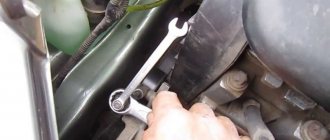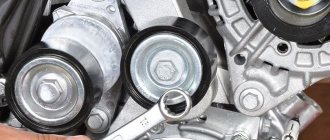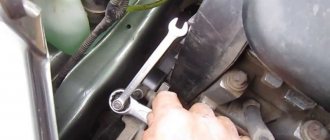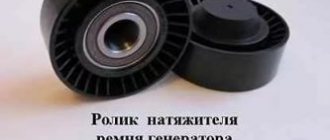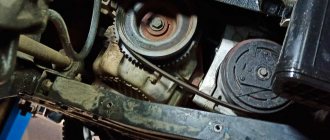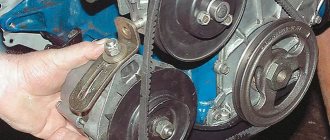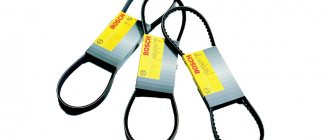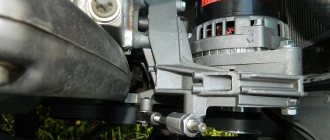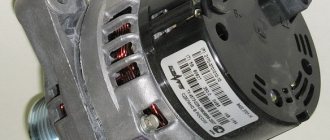Adjustment methods
Currently, there are three main methods of tensioning the alternator belt in cars:
- Using a special arc-shaped strip. In this case, the generator has two mounting points. One of them is an axis around which it can move within small limits. The other is the nut on the adjustment bar. If you release it, you can move the pulley to the required distance. This method is now considered obsolete. It is mainly used on VAZ classics.
- The generator is moved by rotating the adjusting bolt. This system has become widespread in cars of the tenth family.
- Using a tensioner. This is a special movable roller that rests on the belt between the generator and crankshaft pulleys. It is equipped with a screw mechanism. By rotating it, you can adjust the pressing force. This is exactly the kind of alternator belt tensioner on the Lada Kalina.
Removing and checking the timing belt, support and tension roller on Kalina 16-cl.
So, first of all, remove the alternator belt. Then remove the timing belt cover using a ratchet and a Torx t30 bit.
After unscrewing all the bolts, smoothly remove both the upper and lower parts of the casing.
Then the entire timing mechanism becomes available to us, which is clearly shown in the photo below.
Now you need to unscrew the crankshaft pulley bolt from below. The best way to do this is to remove the right front wheel. To prevent the crankshaft from rotating when unscrewing, you need to do the following:
- put an assistant behind the wheel
- engage fifth gear
- press the brake
- at this moment unscrew the pulley mounting bolt
Or block the wheels with a brick, engage fifth gear and unscrew the bolt.
Also, when everything turns easily, we finally unscrew the bolt by hand and remove the pulley along with the washer. Next, you need to install the Kalina timing belt according to the signs. To do this, engage fifth gear and turn the suspended wheel (for example, to the right) by hand, turning the engine crankshaft. Therefore, it is necessary to ensure that the marks on both the camshaft gears and the crankshaft are aligned:
The best varieties are:
After locking the camshaft gears (this is not necessary), you can unscrew the roller bolts, both support and tension, with a 15 mm wrench.
Be sure to check the condition of the bearings and, if necessary, replace them with new ones. By the way, the pump should also be checked for play, rotation and leaks. Also, if any defects are found, replace them.
In addition, when unscrewing the rollers, it is possible to remove the Kalina timing belt, since nothing else interferes with it:
Advantages of a tensioner
Why weren't designers happy with the previous adjustment methods? Why did they add an extra video? It's not just about convenience. The tensioner significantly increases the service life of the generator. Without a roller, the entire load falls on its bearings. If the belt is tensioned normally, then there is nothing to worry about. In this case, the generator will last many thousands of kilometers. However, very often car owners overtighten the belt, and this is bad.
The load on the bearings increases many times over, so they quickly fail. In itself, this is not so scary and expensive, although repairing a generator is quite labor-intensive. But the car owner does not always recognize the breakdown in time. The bearings gradually “break”, the rotor moves and begins to cling to the stator winding. The result is the need to purchase a new generator. Of course, the Kalina generator belt tensioner pulley can also fail, which happens quite regularly, but that’s only 400 rubles, not twelve thousand.
Design
The main element of the tensioner is the pressure roller. It is made of plastic, and a sealed bearing is pressed inside. The roller is mounted on its own bracket, which, with the help of a threaded rod, can move in a vertical plane. This ensures the required moment of pressure on the belt. To prevent the bracket from moving spontaneously when the car is moving due to engine vibration, the pin is tightened on top with a locknut. The entire structure is placed on the generator bracket. There are two holes in it for attaching the Kalina generator belt tensioner.
conclusions
Replacing the belt and generator roller on an 8-valve Lada Kalina is very easy and simple. A wide range of product choices will not suit every consumer's taste. Moreover, even analogues of original parts are of fairly high quality. Diagnosing faults is easy and can be done by any motorist.
An extraneous whistle may disturb you. Having delved into the essence of the breakdown, it turns out that the cause is the alternator belt. You can try to solve this problem yourself, or you can visit a car service center.
In any case, no matter which solution to this problem you choose, it is still worth familiarizing yourself with the generator belt drive device. Regardless of the car brand, each unit has a generator. The transmission of rotation from the crankshaft to the generator shaft occurs using a belt, which often causes breakdowns or malfunction of the car. In order to accurately determine that the reason lies precisely in the belt, you first need to know what it is.
Most common faults
During operation, the surface of the roller is constantly in contact with the generator belt. In addition, it is in continuous rotation, which places additional demands on the reliability of its bearings. The tensioner bracket is also subject to heavy load. Hence the main problems:
- Bearing wear. It simply runs out of service life or becomes unusable due to dust and dirt getting on it.
- Damage to the work surface. As already mentioned, the roller itself is made of plastic. Despite its high wear resistance, it often cannot withstand loads. This manifests itself in the form of scratches and chips, which quickly render the alternator belt unusable.
- Misalignment. This means that the belt and tensioner are at a certain angle to each other. Alignment can be disrupted in both the horizontal and vertical planes (due to the curvature of the bracket). This always causes rapid wear of the belt and the roller itself.
Often the cause of the malfunction is the driver himself. When trying to make adjustments, he forgets or does not loosen the locknut enough. As a result, the hexagon of the stud breaks off, and the Kalina generator belt tensioner fails.
We change bearings in Lada Kalina
The rectifier units present in the designs of generator sets of the AvtoVAZ model range have received a considerable number of negative reviews during operation. This statement is also true for the Lada Kalina we are considering. These modules can break down even after a mileage of 10 thousand km, which requires repair or replacement of the device. It has also been revealed in practice that the cause of most malfunctions is the generator set bracket. However, bearings can also fail prematurely. It is gratifying that the owners are able to cope with such a problem on their own.
Symptoms of a problem
Damage to the tensioner is usually easy to diagnose. It is often noticeable visually. Running the car for a short time without an alternator belt helps to identify the problem. This often allows the damage to be localized. You should think about replacing the Kalina generator belt tensioner in the following cases:
- Presence of traces of rust and corrosion on the roller axis.
- A characteristic whistle when the engine is running.
- Short service life of the alternator belt.
- Curvature of the roller relative to the belt.
If the cause of the malfunction is precisely established, you can proceed to its elimination.
Replacing the tensioner
The device consists of several elements, each of which is removable. Therefore, the need to replace the Lada-Kalina alternator belt tensioner assembly does not arise so often. As a rule, it is associated with mechanical damage to the bracket and stud.
Replacement work must begin with preparing the tool. No special variety is required; keys 8, 13 and 19 are sufficient. Replacement is carried out in the following sequence:
- Use a 19mm wrench to loosen the tensioner locknut.
- Using a 8 key, rotate the pin clockwise. Here you need to be careful and not put in much effort. If rotation is difficult, it is better to loosen the locknut a little more.
- The pin is released until the roller no longer acts on the belt.
- By unscrewing two 13mm bolts, you can completely remove the tensioner.
Here you need to pay attention to one point. Bushings are inserted into the tensioner mounting holes. When removed, they often fall out and get lost, and they may not be present on the new tensioner. Bushings are necessarily included in the kit, but not everyone knows about their existence, so they don’t check it when purchasing. Installation of the Kalina generator belt tensioner is carried out in the reverse order. The pin is tightened with a force of 0.18 kgf/m.
If you need to replace the roller or brushes?
When, during operation of the engine, the owner of a Lada Kalina hears a distinct “rustle” coming from the rotating roller of the tension unit, then a detailed inspection of this element will be required and, if necessary, replaced.
To carry out this repair operation, it is recommended to stock up with ordinary keys and a screwdriver with a flat-tipped tip. All replacement procedures do not cause any difficulties, so we act with confidence.
- First, we resort to loosening the degree of belt tension. To do this, unscrew the stem.
- Using the designated screwdriver, carefully pry up the protective cap of the roller and unscrew the bolt holding the bearing.
- From the worn-out roller we remove the bushing together with the washer (they are necessary for installation in conjunction with a new product).
- The entire assembly is mounted in its proper place and secured with a bolt.
- We tighten the belt and start the engine. We make sure that the new product functions correctly.
One of the factors characterizing weak battery charging is wear on the brushes of the generator set. In order to eliminate this negative aspect, the generator brushes will need to be replaced. To monitor their condition, they will need to be dismantled. Replacing generator brushes is available both on a removed generator set and on one installed on a Lada Kalina car.
In order to achieve safety of work and eliminate the risk of a short circuit in the circuit, before repair work it will be necessary to disconnect the network from the battery (remove the terminals). Now you need to dismantle the protective cover and remove the plug. This can be done conveniently using the previously designated screwdriver.
At the final stage of the process, unscrew the bolts, after which we remove the regulator itself with the brushes present on it. Replacement of generator brushes is complete. Brush wear is assessed by measuring their height. This parameter should not be less than 5 mm. If the brushes are worn out, then replace them and the regulator included.
Forced tuning
Unfortunately, since 2011, designers have abolished the tensioner on Kalina. They were guided primarily by considerations of economy, but they did this without any modification to the generator. In practice, cases of its premature failure immediately became more frequent. Therefore, owners began to install the tensioner on their cars themselves.
It's not very difficult to do this. True, you will have to purchase not only the tensioner itself, but also the generator bracket. The only problem is removing the standard belt. It is very difficult to remove because it is very tight at the factory. You can simply cut it, as you will have to buy a new one. The fact is that the Kalina generator belt without a tensioner has a size of 820 mm, but 880 will be needed.
Why, when and which belts are best to install: timing belt and features of belt drive
Let's start right away with when to change the timing belt. The timing belt replacement interval is on average 60 thousand km. However, it is important to understand that many additional factors affect the life of a product.
In some manuals for some cars you can find instructions that suggest replacing the belt after 70-80 thousand km, while for other cars the replacement is clearly stated at 50-60 thousand. Based on this, in practice, motorists have long developed a rule for themselves to change the belt at an average level. Thus, it turns out that such an indicator can be considered the mark of 50 or maximum 60 thousand km.
Let's move on. Before answering the question of which company to choose a timing belt and which brand of timing belt is the best, let us dwell on the problems associated with this element and its operation. It should be remembered that not only the camshaft drive, but also the precise synchronization of the valve timing with the strokes of the internal combustion engine depends on the timing belt.
Experts identify a number of reasons why problems may arise:
- The timing belt tension is too strong or too weak. In the first case, the problems are associated with incorrect installation, and the belt itself quickly stretches. Under such conditions, rollers, timing gear drive bearings and other elements (for example, a pump) are subject to increased wear.
If the timing belt is not tensioned enough, the life of the product is reduced and may even slip on the pulleys. Moving even a “tooth” leads to engine malfunction or failure of the internal combustion engine. To prevent possible consequences, it is recommended to check the tension closer to half of the total belt life. If the timing belt becomes loose, it must be tightened or replaced.
- The belt was replaced with a new one, but the timing rollers were not changed. This is a common situation related to the desire of owners to save money. Remember that the timing belt needs to be changed depending on the mileage. If the time has come to replace the belt, then the replacement is carried out along with the rollers and regardless of the general condition of these elements.
As practice shows, during testing the rollers may not make noise and rotate normally, but after a short period they may still stop. As a result, the belt breaks with all the ensuing consequences.
The only exception can be considered only a forced replacement of the belt under the influence of certain factors. These include: oil and technical fluids getting on the belt, delamination and cracking, mechanical damage, etc. In simple terms, if the rollers with the belt were changed not so long ago, but then the belt quickly became damaged, then you can simply replace the belt.
In this case, it should be separately taken into account that the declared service life of the new belt will no longer correspond to the total service life of the rollers. For example, if the total service life of a new set of belts and rollers is 50 thousand km, but the belt fails after 20 thousand km, after installing the new belt it is optimal to subtract the 20 thousand km that the rollers have already passed.
It turns out that it is better to replace the next belt installed together with the rollers after 30, rather than 50 thousand km. In this case, the main task is to avoid jamming of the rollers, which leads to breakage of the drive belt.
- The vehicle is constantly operated at high temperatures. As you know, the timing belt is a rubber product. In regions with constant high temperatures, such products tend to dry quickly, lose elasticity and crack.
The same belt manufacturers separately indicate the need to reduce replacement intervals (by at least 20-30%) for vehicles in similar conditions. We also add that any defects in the timing belt protective cover lead to dirt, engine oil and other technical fluids settling on the belt in the engine compartment (depending on the general condition and malfunctions of the internal combustion engine). In this case, the planned life of the product is significantly reduced.
The best timing belt manufacturers
So, having understood the features and nuances of operating / replacing belts, you can move on to the subtleties of their selection. Today, the market offers products from domestic and foreign manufacturers.
The entire list is quite extensive, so we will focus on the most popular solutions. When it comes to which timing belts are the best, Gates, Contitech, Dayco and Bosch are the most respected and popular in this segment.
- The undisputed leader, who always makes its presence felt, is the manufacturer Gates. This Belgian company specializes in the production of drive belts for internal combustion engines and various specialized equipment. Let us add that the manufacturer supplies its products directly to the conveyor belts of many of the largest automotive giants.
- The German company Contitech is also on the list of large manufacturers whose products are installed on new cars during assembly. In parallel, the company produces drive mechanisms, air suspension elements and other automotive parts.
- Dayco is an Italian company. The company specializes in the production of drive belts, rollers, bearings and other elements of transmission mechanisms. The German company Bosch, widely known among motorists, also offers high-quality timing belts in a huge range of auto parts.
Which timing belt is better to buy?
When it comes to choosing the right replacement belt, there are several options.
- The most expensive, but at the same time safer, purchase of goods from the official service and subsequent installation is usually carried out in one place. Let's see why this is so.
In other words, for example, an original brand timing belt for Opel/Chevrolet vehicles is offered under the GM brand under its own catalog number. At the same time, these products are not manufactured by General Motors itself; the well-known company Gates supplies belts for GM.
At the same time, the cost of an original GM belt from officials turns out to be on average 40-50% or more, and in retail it is 20-30% higher than exactly the same belt, but under the brand. Gates. It turns out that such a belt is cheaper and is in no way inferior in quality to its non-original counterpart.
Taking into account the above, it becomes clear why, after removing the old belt for the first replacement, it turns out that the car straight from the factory contains products under the Gates or Contitech brands, although the original part in the catalogs is designated as GM, AUDI, Volkswagen, etc.
To be fair, we add that there are different opinions on this matter, since many drivers argue about the difference in the quality of original and non-original spare parts. The main argument is that manufacturers supposedly put better products on conveyor belts, while lower quality products are sold at a lower price under their own brand.
- One way or another, this information allows you to choose a second and more convenient way to select a belt. If the vehicle was originally equipped with a Gates or Contitech product, or if you know exactly which manufacturers supply belts to your vehicle manufacturer, there is no need to purchase an original belt.
It will be enough to replace it with exactly the same high-quality analogue from one or another company supplying spare parts to the plant. As practice shows, such products serve no worse than the original.
- You can also not adhere to the rules at all, immediately choosing the appropriate option. In all cases, special attention should be paid to counterfeits. And this is a significant and undeniable drawback of both the second and third methods.
High-quality original belts from Contitech, Gates, Bosch or Dayco are reliable products that will perform just as well and perform reliably (as long as they are installed correctly and other vehicle maintenance and operating requirements are met).

